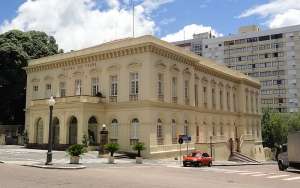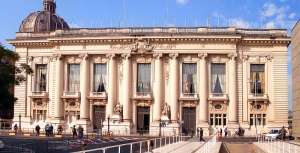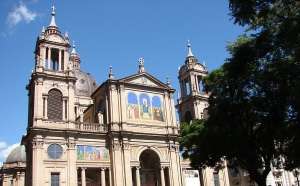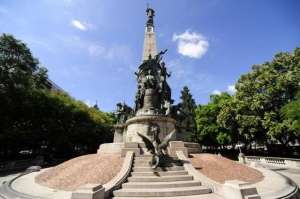|

A Praça Marechal Deodoro, mais conhecida como Praça da Matriz, é um espaço público e histórico da cidade de Porto Alegre, capital do estado brasileiro do Rio Grande do Sul. Está localizada no coração da cidade, no Centro Histórico, e existe desde os primórdios da capital.
A primeira menção que há do local da praça remonta ao ano de 1753, quando ali foi construído um cemitério. O seu lado sul foi o primeiro a ser ocupado, construindo-se ali a Igreja Matriz. Em consequência disso, o seu nome passou a ser Praça da Matriz. Pouco tempo depois, em 1772, aparece no primeiro mapa da pequena povoação que era Porto Alegre em seus primórdios, como Praça do Novo Lugar. Quando a capital da Capitania foi transferida de Viamão para Porto Alegre, a praça foi escolhida para abrigar o Palácio do Governador, concluído em 1789, passando a ser conhecida também como Praça do Palácio da Presidência. Ao lado do Palácio, apareceu em 1790 a Casa da Junta ou da Real Fazenda e, entre 1837 e 1839, ao lado da Matriz, a primeira Capela do Espírito Santo.

Vista da praça na sua primeira urbanização, em 1890
Estabelecendo-se lentamente, a praça até 1840 não passava de uma elevação erodida, sem qualquer adorno. Nessa década, foram então construídas as primeiras calçadas, e na segunda metade do século XIX, passada a agitação causada pela Revolução Farroupilha, quando a cidade foi sitiada por dez anos, outros edifícios importantes foram sendo construídos no seu entorno, como o Palácio do Ministério Público, a sede da Sociedade Bailante, a primeira hidráulica da cidade, a primeira sede da Intendência municipal, o Theatro São Pedro e o seu edifício gêmeo (este sede da Câmara Municipal) e a Junta Criminal.

Theatro São Pedro
Em 1858, o seu nome foi alterado para Praça Dom Pedro II, por ocasião da visita do Imperador à capital da província. Logo depois foi instalado um chafariz, com estátuas de mármore, que simbolizavam os grandes rios da Bacia do Guaíba, hoje transferidos para a Praça Dom Sebastião, e resolveu-se dar início à arborização.
O ajardinamento só foi empreendido de facto entre 1881 e 1883, incluindo 20 oliveiras vindas de Portugal. Em 1885 recebeu o Monumento ao Conde de Porto Alegre, depois removido para a praça que leva o seu nome, a Praça Conde de Porto Alegre. Em 11 de dezembro de 1889, um decreto municipal alterou o nome do logradouro para Praça Marechal Deodoro, que conserva até aos dias de hoje. Em 1896, o antigo Palácio do Governo foi demolido para dar lugar a uma sede mais ampla e luxuosa, o atual Palácio Piratini.

Palácio Piratini
Em 24 de outubro de 1914, foi inaugurado o Monumento a Júlio de Castilhos, em homenagem ao grande estadista gaúcho Júlio de Castilhos. O monumento em bronze, construído na gestão do governador Carlos Barbosa, foi criado pelo escultor Décio Villares. Cercam a figura central do governante diversas personificações de virtudes, como a Coragem e a Prudência, e de valores e instituições, como a Educação e o Civismo. Pouco depois, a antiga Matriz era demolida para a construção de uma catedral maior, a presente Catedral Metropolitana de Porto Alegre.

Catedral Metropolitana
Posteriormente, a Praça recebeu grandes melhoramentos, que foram concluídos em 1919. Em 1927, onde se localizava o antigo prédio da Assembleia Legislativa, foi construído o primeiro Auditório Araújo Viana, para concertos da banda municipal, e que foi demolido na década de 1960 para erguer-se em seu lugar o moderno Palácio Farroupilha, sede do Poder Legislativo do Estado. Nas vizinhanças imediatas da Praça da Matriz encontram-se ainda o Solar dos Câmara, o Museu Júlio de Castilhos e a Biblioteca Pública do Estado, todos em edificações históricas.

Monumento a Júlio de Castillos
|
|

The Marshal Deodoro Square, better known as Matriz Square is a public and historic space of Porto Alegre, capital of the Brazilian state of Rio Grande do Sul. It's located in the heart of the city, in Centro Histórico, and exists since the beginnings of the capital.
The first mention to the site of the square dates back to 1753, when there was built a cemetery. Its southern side was the first to be occupied, with the construction of the Matriz Church. As a result, its name became Matriz Square. Shortly thereafter, in 1772, it appears on the first map of the small town that Porto Alegre was in its infancy, with the name New Place Square. When the capital of the Captaincy of Viamão moved to Porto Alegre, the square was chosen to house the Governor's Palace, completed in 1789, and also became known as the Presidential Palace Square. Beside the palace, appeared in 1790 the Junta House ou Real Fazenda and, between 1837 and 1839, beside the Matriz, the first Chapel of the Holy Spirit .

View of the square in its first urbanization, in 1890
Settling itself slowly, until 1840 the square was only an elevation eroded without any adornment. In that decade, were then built the first sidewalks, and in the second half of the nineteenth century, after the agitation caused by the Farroupilha Revolution, when the city was besieged for ten years, other important buildings were built in its surroundings, like the Palace of the Public Ministry, the headquarters of Dancing Society, the city's first hydraulic, the first seat of the municipal Quartermaster, Theatro São Pedro and his twin building (the headquarters of city Hall) and Criminal Board.

São Pedro Theatre
In 1858, its name was changed to Dom Pedro II Square, during the visit of the Emperor to the capital of the province. Soon after, a fountain was installed with marble statues which symbolized the great rivers of the Guaiba Basin, today transferred to Dom Sebastião Square, and the afforestation was started.
The landscaping was undertaken only between 1881 and 1883, including 20 olive trees brought from Portugal. In 1885 it received the Monument to the Count of Porto Alegre, then removed to the square that bears his name, Conde de Porto Alegre Square. On December 11, 1889, a municipal decree changed its name to Marechal Deodoro Square, the actual name. In 1896, the former Government Palace was demolished to make way for a wider and luxurious headquarters, the current Piratini Palace.

Piratini Palace
On October 24, 1914, was inaugurated the monument to Julius de Castillos, in honor of the great gaucho statesman Julius de Castillos. The bronze monument, built in the management of Governor Carlos Barbosa , was created by sculptor Decio Villares. The central figure of the ruler is surrounded by several personifications of virtues, such as courage and prudence, and values and institutions, such as Education and Civics. Shortly after, the old church was demolished to build a larger cathedral, the present Metropolitan Cathedral of Porto Alegre .

Metropolitan Cathedral
Subsequently, the Square has received major improvements, which were completed in 1919. In 1927, where the old building of the Legislative Assembly was located, was built the first Araújo Viana Auditorium, the stage of the municipal band, which was demolished in the 1960s to erect in its place the modern Farroupilha Palace, seat of the State's Legislative Power. In the immediate vicinity of the main square there are still the Solar dos Câmara, the Julius de Castillos Museum and the State's Public Library, all of them in historic buildings.

Monument to Júlio de Castillos
|